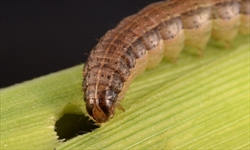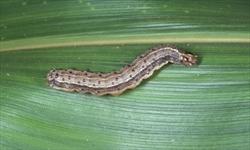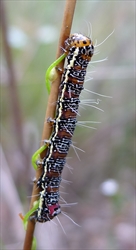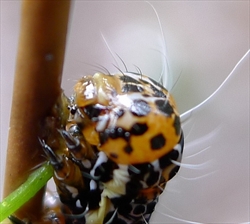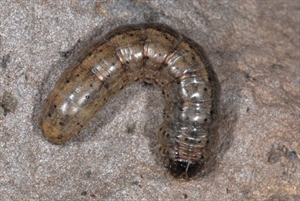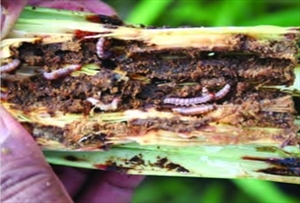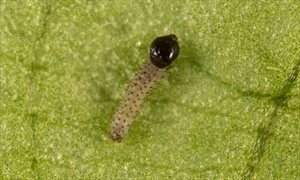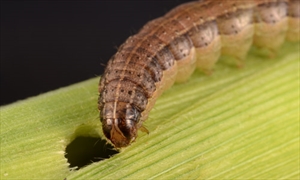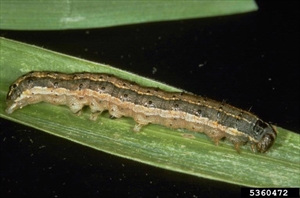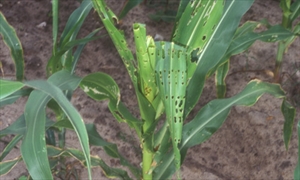Background
The Noctuidae is a large family of moths in the superfamily Noctuoidea, which comprises about 1,089 genera and 11,772 species worldwide, and many undescribed species. Most noctuids are in the so-called ‘trifine’ subfamilies, mainly the Noctuinae (cutworms), Heliothinae and Amphipyrinae, but there are 21 subfamilies altogether. This family is very diverse in form and biology and cannot easily be defined on adult or larval morphology. The group includes many agricultural pests, such as the familiar cutworms and armyworms, found in subfamilies such as the Noctuinae (cutworms) (Fig. 4, Fig. 5 , Fig. 8), and Heliothinae and Acronictinae respectively.
The Noctuoidea has recently undergone a revolutionary taxonomic revision with many taxa originally classified under the Noctuidae, but now transferred to the new family Erebidae, currently the largest noctuoid family (Zahiri et al. 2013, Regier et al. 2017). The six family constituents of this superfamily are now well-established and are as follows: Oenosandridae, Notodontidae, Euteliidae, Erebidae, Nolidae and Noctuidae.
Noctuids can most easily be confused with the Erebidae and Geometridae. All three families include caterpillars that can be classified as loopers, with varying degrees of proleg loss and reduction, although most Geometridae, by far, have lost prolegs on A3-A5. Looper caterpillars in the Erebidae and Noctuidae are commonly called ‘semi-loopers’ (Fig. 10) to differentiate them from geometrids (see information below on separating loopers form semi-loopers). Geometrid larvae are not ‘hairy’ caterpillars unlike many in the Erebidae (esp. Arctiinae and Lymantriinae) and Noctuidae (esp. Acronictinae and Pantheinae) as mature geometrid larvae very rarely have secondary setae, which, when present are confined in small numbers to the prolegs. Primary setae are usually also short in mature geometrid caterpillars.
The loss or reduction of prolegs in caterpillars enables faster mobility. This adaptation commonly occurs in arboreal lineages. Looping may have first evolved in early instars of caterpillars as a dispersal mechanism and then later became established in mature larva of some groups.
A diagnosis of the Noctuidae and descriptions of some subfamilies are provided below. The largest and most economically important subfamilies are the Noctuinae (cutworms) (Fig. 4, Fig. 5, Fig. 8), Heliothinae and Amphipyrinae.
Subfamilies
The current 21 subfamilies are as follows:
- Acontiinae
- Acronictinae
- Aedinae
- Agaristinae
- Amphipyrinae
- Bagisarinae
- Balsinae
- Bryophilinae
- Condicinae
- Cuculliinae
- Dilobinae
- Dyopsinae
- Eucocytiinae
- Eustrotiinae
- Heliothinae
- Metoponiinae
- Noctuinae
- Oncocnemidinae
- Pantheinae
- Plusiinae
- Raphiinae
Short Description
Semi-loopers vs Loopers
Looper caterpillars are those that move by alternatively arching and straightening their bodies, much like a leech, to move quickly along the substrate. This form of movement is usually accompanied by the loss or reduction of prolegs on abdominal segments A3-A5 and is most likely an adaptation for ease of movement in arboreal habitats. The prolegs on A6 and A10 act as clamps securing the caterpillar to the substrate while it moves around or stays stationery. Loss of prolegs also contributes to camouflage such as twig mimicry. Looping is most characteristic of the family Geometridae, which are also known as inchworms. However this morphological adaptation has also occurred convergently in noctuoid families, most notably the Erebidae, Noctuidae and Nolidae. In these, looping caterpillars are known as semi-loopers (Fig. 10), distinguishing them from the geometrid loopers. Consequently, it is sometimes difficult to differentiate caterpillars from these different families but the following points should aid in the identification process:
- All loopers (including semi-loopers) show either reduction or loss of prolegs on abdominal segments A3-A5 (Fig. 10)
- An important point of difference between geometrid and noctuoid loopers is that the A5 proleg is similar in size to the A6 proleg in the latter (Fig. 10), but in the vast majority of cases is smaller in geometrids (but see the Geometridae fact sheet)
- The presence of four lateral setae on the abdominal segments is diagnostic for geometrid caterpillars. There are only three other groups known that have this extra L seta in caterpillars, the Acronictinae and Dilobinae in the Noctuidae, and the Arctiinae in the Erebidae. However none of these non-geometrid caterpillars are semi-loopers. Thus loopers can be separated from semi-loopers on the presence of this extra lateral seta. Also, both Acronictinae and Arctiinae are hairy caterpillars with abundant secondary setae, immediately separating them from geometrids
- Nolid semi-loopers, only, have reduced or no prolegs on A3 with that of the A4 fully developed. Additionally nolid larvae generally have secondary setae, which means they cannot be confused with geometrids, or any semi-looper noctuids with prolegs reduced on absent from A3.
Description
Adapted from Stehr et al. (1987) and Kitching & Rawlins (1998).
The following are a list of characteristic features of the Noctuidae. The bisetose condition of the SV setae of the first abdominal segment is listed first, as this is diagnostic for the Noctuidae. The presence of a tonosensillum on A9 is also a useful character to identify many noctuids and pest species such as Spodoptera (armyworms) (Noctuinae, cutworms). The rest of the characters are only partially diagnostic for the family, only occurring in certain subfamilies. This information is noted in the text below appended to each character.
Diagnosis
Adapted from Kitching & Rawlins (1998) and Zahiri et al. (2013).
- Setae - A1, SV setal group
- Bisetose- loss of SV2. In most Noctuidae, including the trifine subfamilies, Noctuinae, Heliothinae and Amphipyrine and Acontiinae, Acronictinae, Eustrotiinae (part) and Plusiinae (part). But this is also a character of the Australian genus Oenosandra (Oenosandrinae), Euteliidae and many notodontids without secondary setae.
- Trisetose. This character is widespread in the Noctuoidea (Oenosandridae, Notodontidae, Euteliidae, Erebidae, Nolidae and Noctuidae).
- A9, SD1
- SD1 is enlarged forming a very fine, and relatively long tonosensillum. In Noctuinae (e.g. Spodoptera frugiperda), Acronictinae, Stiriini (Amphipyrinae), Condicinae, and some Plusiinae (esp. the Argyrogrammatini) and most trifine species. This character is considered to be diagnostic for the Noctuinae.
Other characteristic features:
- Mouthparts
- Spinneret
- Dorsoventrally flattened, often sinuous, with apical fringes. In most Noctuinae and a few other trifine noctuids. In other Lepidoptera it is usually a tubular structure.
- Reduced. Acontiinae (often), Stirini (Amphipyrinae) and Condicinae.
- Long. The spinneret of the tribe Hadenini (Noctuinae) is long - more than twice the length of its width.
- Raduloid laterally on the larval hypopharynx In the Plusiinae. A raduloid is a sclerotised comb.
- Spinneret
- Prolegs
- Full complement and development in mature instars. Agaristinae (Fig. 1), Noctuinae (Fig. 8), Raphiinae, Dilobinae, Psaphidini (Amphipyrinae), Dyopsinae and Acronictinae. Noctuinae sometimes have reduction in proleg size in early instars only.
- Reduction in size (and sometimes number) in mature larvae (semi-loopers). Eustrotiinae, Pantheinae, Plusiinae, Acontiinae and Bagisarinae. Also in the quadrifid groups Arctiinae, Herminiinae, Lymantriinae (all in the Erebidae) and Nolidae.
- Prolegs absent on A3-A4. Acontiinae
- Plusiinae
- Tribe Abrostolini: Full complement, but A3 and A4 are more slender than those on A5 and A6.
- Tribe Argyrogrammatini: A3 and A4 have vestigial prolegs that lack crotchets
- Bagisarinae: In most taxa, prolegs on A4 are either reduced, with minute crotchets, or are absent
- Crochets
- Setae
- A7-A9
- SV bisetose. Agaristinae.
- T1
- L2 lies directly posterior to L1. Most Heliothinae.
- L1 on T1 is vertically above seta L2. In most noctuids.
- T2 and T3
- SV seta unisetose. Synapomorphic for at least most of the Noctuinae. Also in the Notodontidae and Nolidae. Bisetose in the Glottulini (Noctuinae), some Plusiinae and Dyopsinae.
- The dorsal pinacula are often fused over T2 and T3. Acronictinae, Dilobinae.
- A3-A6, 4 L seta. Acronictinae, Dilobinae (based on one species Diloba caeruleocephala) and also the Arctiinae (Erebidae). This is an unusual character that separates these groups from most Lepidoptera. It is diagnostic for the Geometridae. In the Noctuoidea, an extra L seta in these abdominal segments is never found in semi-loopers either in the Noctuidae or the Erebidae.
- Secondary setae
- Absent (Fig.1, Fig. 2, Fig. 4, Fig. 8, Fig. 10). In most subfamilies.
- Present. Acronictinae, Pantheinae. The degree of development of secondary setae varies even within subfamilies. Pantheinae have verrucae-based secondary setae and also secondary setae on the head.
- A7-A9
- Integument
- Subspiracular stripe A10 – suranal plate
- Extends up and around the anal plate instead of continuing down the anal proleg. Cuculiinae, Acronictinae, Amphipyra (Amphipyrinae) and elsewhere in Noctuidae (e.g. Plathypena) (Hypeninae).
- Continues down the anal proleg. Noctuinae, e.g. Spodoptera (Fig. 8).
- A8 – the whole segment is enlarged into a hump (sometimes with an apical protrusion). In the Acronictinae, Condicinae and Amphipyrinae.
- Head capsule with triangular, pale frontal area, lateral of the adfrontal sutures, often including the frons. In the Agaristinae (e.g. Hecatesia) (Fig. 3), the Noctuinae (e.g. Agrotis (Fig. 4) (e.g. Spodoptera) (Fig. 7), but also diagnostic in the Anthelidae.
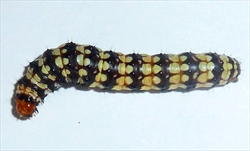
Fig. 2. Mature caterpillar of Brithys crini (Noctuidae: Noctuinae) the amaryllis borer, crinum borer, lily borer or Kew arches, which occurs in the Northern Territory and Queensland. This caterpillar was found feeding on Clivia (natal lily or bush lily) in Pretoria, South Africa. Photo by JMK - Own work, CC BY-SA 3.0, https://commons.wikimedia.org/w/index.php?curid=44331588
Detailed Description
Adapted from Stehr et al. (1987) and Kitching & Rawlins (1998).
Usually moderately large larvae with hypognathous heads, generally lacking secondary setae and not appearing hairy (Fig.2, Fig. 3, Fig.4, Fig. 7, Fig. 8, Fig. 10), except for caterpillars of some species belonging to the Acronictinae and Pantheinae. However, some caterpillars may have long primary setae, and may appear to be hairy (but not caused by the presence of abundant secondary setae) (Fig.1). Prolegs vary widely in development from a full complement with well-developed prolegs, to a loss and/or reduction in size on A3 and A4 (Fig. 100. Noctuid semi-loopers can be differentiated from geometrid loopers on the relative size of the A5 and A6 prolegs. In geometrids, the A5 prolegs are smaller than A6 prolegs, whereas in noctuids they are very similar in size (Fig. 10). Crochets are usually a homoideous mesoseries. Nolid larvae are separated by the absence or reduction of prolegs on A3, with A4 fully developed.
The body is typically cylindrical and stout (Fig. 1, Fig. 2, Fig. 4, Fig. 8, Fig. 10). The abdominal segment A8 is often enlarged and humped and sometimes sports an apical protrusion. The integument can be smooth, granular or spinose. Secondary setae are present in some Acronictinae and Pantheinae. Patterns are common with chevrons, triangles, stripes and transverse bands (mainly the Agaristinae) (Fig.1) (but see Fig. 8). Spiracles are generally elliptical, with those on T1 and A8 larger than those on A1-A7.
Head: Usually hypognathous (Fig. 1). The frontoclypeus is normally triangular. The adfrontal ecdysial lines are close to the frontoclypeal margins. There are six stemmata, with 1-4 in a semicircle with variable spacing and 5 and 6 removed from the 1-4 semicircle with an imaginary line extending through 5 and 6 not passing through the semi-circle. The head capsule sometimes has a triangular, pale frontal area, lateral of the adfrontal sutures, often including the frons (some Noctuinae (cutworms) and Agaristinae) (Fig. 3, Fig. 4, Fig. 8).
Thorax: The prothoracic shield is usually well formed, but may be indistinct if the same colour as the rest of the body (Fig. 2, Fig. 7).
T1: the setae XDI and XD2 are positioned near the anterior margin and D1 and D2 are close to the posterior margin of the shield. SD1 and SD2 are close to each other and SD1 is usually thinner than SD2. L1 and L2 arise close to each other, anterior of the spiracle. L2 is usually thinner than L1. SV1 and SV2 are present above the leg.
T2 and T3: D1, D2, and SD2 insertions lie in an approximate straight line; SD1 is usually hairlike, and situated below and usually separate from SD2. L1, L2, and L3 are present. The SV group is usually unisetose, whereas the Old World genus Brithys (Noctuinae: Hadenini) has 2 SV setae. Brithys crini, the amaryllis borer, crinum borer, lily borer or Kew arches, occurs in the Northern Territory and Queensland (Fig. 2).
Abdomen: D1 and D2 are present. D1 is dorso-anterior of D2 on A1-8. On A9 D1 is ventro-anterior of D2. SD1 is dorsad and SD2 anterior of spiracle. SD2 is absent on A9. The L group has three setae (but there are four in Acronicta (Acronictinae) and Diloba caeruleocephala (Dilobinae) on A3-6. L1 is directly posterior of the spiracles on A3- A6 but is usually ventroposterior of the spiracle on A7. The SV group has two setae on A1. A8 is sometimes enlarged into a hump (sometimes with an apical protrusion). The A9 has only one seta in the L group. The suranal shield is present but is not always conspicuous. The subspiracular stripe, when present on the A10, can either extend up and around the anal plate (Cuculiinae, Acronictinae, Amphipyra (Amphipyrinae) and elsewhere in Noctuidae (e.g. Plathypena (Hypeninae)) or continue down the anal proleg (Noctuinae) (Fig. 8).
Species of Biosecurity Concern
THE FOLLOWING SPECIES ARE OF BIOSECURITY CONCERN TO NORTHERN AUSTRALIA
The following five species of noctuid moths are of biosecurity concern for northern Australia. Four of these belong to the subfamily Noctuinae (cutworms).
Subfamily Noctuinae
Characteristics of the Noctuinae
The following species, turnip moth Agrotis segetum, pink stalk borer Sesamia grisescens, Asiatic pink stem borer Sesamia inferens and fall armyworm Spodoptera frugiperda all belong to the hadenine tribe of the Noctuinae (cutworms).
Setae
- Tonosensilla on A9 especially in the Hadenini. The tonosensilla are enlarged, long and thin SD1 setae on A9.
- In many, the subspiracular stripe continues down the anal proleg (Fig. 8).
- Often, the head capsule has a triangular, pale frontal area, lateral of the adfrontal sutures, often including the frons (e.g. Agrotis, Spodoptera, Hadenini) (Fig. 4, Fig. 7).
Biology
- Generally polyphagous
- Feed on herbaceous angiosperms
- Mature larvae tend to shelter during the day in soil or under broad-leaved plants. Cut leaves at night and consume them in shelters (cutworm behaviour)
- Agricultural pests (e.g. Agrotis (cutwoms), Spodoptera (armyworms) and Proteuxoa)
***
Agrotis segetum (Noctuinae: Hadenini) (turnip moth, black cutworm, common cutworm, cutworm, dark moth, dart moth, tobacco cutworm, turnip dart moth)
This is a common European species that has spread through trade to Asia and Africa. Like other species in the genus, it is a cutworm, which attacks the roots and stems of an enormous variety of plants, covering 25 families. This species is regarded as one of the most economically damaging in this large genus of cutworms.
Description
The mature caterpillars are stout and grey, sometimes tinged with purple and have a slightly greasy texture. The head capsule is mainly black with the typical hadenine, triangular, pale frontal area, lateral of the adfrontal sutures (upside-down Y) (Fig. 4). The integument of the abdomen is covered with conical granules. Length of mature larvae, approximately 45 mm (CABI 2019a) (OCCPO 2011).
Biology and Feeding Damage
Young caterpillars externally feed on leaves, stems, tubers and roots resulting in ‘windows’ in leaves, and holes in stems, tubers and roots. Older larvae cause abnormal leaf fall and leaf pieces partly pulled down into the soil, and, again, holes in tubers and roots. For detailed information on the biology see: https://www.planthealthaustralia.com.au/wp-content/uploads/2013/03/Turnip-Moth-CP-OCPPO-2011.pdf.
Current Distribution
Widespread in Asia, Africa and Europe. For a complete list of countries see: https://www.cabi.org/isc/datasheet/3797
Caterpillar Host Plants
- wattle (Acacia)
- onion (Allium)
- celery (Apium)
- peanut (Arachis)
- asparagus (Asparagus officinalis)
- beet (Beta)
- cabbage (Brassica)
- Camellia
- Casuarina
- deodar cedar (Cedrus)
- Chrysanthemum
- chicory (Cichorium)
- coffee (Coffea)
- Cucurbita
- Eucalyptus
- strawberry (Fragaria)
- soybean (Glycine)
- cotton plant (Gossypium)
- African redwood (Hagenia)
- sunflower (Helianthus)
- bissap (Hibiscus)
- indigo (Indigofera)
- lettuce (Lactuca)
- tomato (Lycopersicon)
- apple (Malus)
- alfalfa (Medicago)
- tobacco (Nicotiana)
- Sitka spruce (Picea)
- pine (Pinus)
- pea (Pisum)
- Douglas fir (Pseudotsuga)
- rhubarb (Rheum)
- dock and sorrel (Rumex)
- sugar cane (Saccharum)
- rye (Secale)
- sesame (Sesamum)
- potato (Solanum)
- Sorghum
- spinach (Spinacia)
- teak (Tectona)
- clover (Trifolium)
- wheat (Triticum)
- urad bean (Vigna)
- grape (Vitis)
- maize (Zea)
***
Sesamia (Noctuinae: Hadenini)
Sesamia grisescens (pink stalk borer, ramu shoot borer)
This stalk borer species is endemic to New Guinea.
Description
The mature caterpillar is light-pink, becoming purplish when fully grown. Length of mature larvae is around 30-50 mm.
Biology and Feeding Damage
Early instars mine the internal leaf sheath and fill the eaten section with frass. As they mature they then bore into the terminal internodes of the stalk. Damage at this stage includes ‘dead heart’ or killing off of the growing point. Mature larvae mine large tunnels in the upper three or four internodes of sugarcanes and other grasses, made evident by large entry holes (Fig. 5). Bored stalks break easily in strong wind. Larvae make exit holes of 5-10 mm before leaving for pupation.
For more information see: https://www.cabi.org/isc/datasheet/49750.
Current Distribution
- Papua New Guinea
- Seram
- the Moluccas
- New Britain
Caterpillar Host Plants
- sugarcane (Saccharum officinarum)
- robust cane (Saccharum robustum)
- wild sugarcane (Saccharum spontaneum)
- duruka, Fiji asparagus, dule, pitpit and naviso (Saccharum edule)
- Napier grass, elephant grass or Uganda grass (Pennisetum purpureum)
- Guinea grass and green panic grass (Megathyrsus maximum)
***
Sesamia inferens (Asiatic pink stem borer, gramineous stem borer, pink borer, pink rice borer, purple stem borer)
This stemborer mainly attacks gramineous plants and is a monsoonal tropical species of Asia and western Oceania.
Description
The mature caterpillar is a somewhat shiny pale, pinkish brown with some darker brown markings. The head capsule is dark brown, and lacks the sometimes characteristic pale inverted Y marking (see Fig. 4). The prothoracic shield is well-developed and yellowish brown in colour. The hairs are very short. Crochets are arranged in a homoideous mesoseries, typical for the Noctuidae. Mature larvae are around 30-40 mm in length.
Images are available here: http://www.nbair.res.in/insectpests/Sesamia-inferens.php
Biology and Feeding Damage
Damage is similar to other stem borers. The caterpillars feed within the stem or at the base of the panicles. Deadheart is caused by the wilting of the stem when severed. Whitehead is caused by the severing of the panicle. Exit holes made by the caterpillars before pupation occur in the tillers (CABI 2019c).
Current Distribution
- Pakistan
- India
- Sri Lanka
- Myanmar
- Japan
- Solomon Islands
Caterpillar Host Plants
- Coix
- Echinochloa
- rice (Oryza)
- Panicum
- sugarcane (Saccharum)
- Setaria
- wheat (Triticum)
- maize, corn (Zea)
- wild rice (Zizania)
For a more complete list of host plants see; https://www.plantwise.org/knowledgebank/datasheet/49751
***
Spodoptera frugiperda (fall armyworm) (Noctuinae: Hadenini)
Fall armyworm belongs to a group of noctuid moths called armyworms. It is one of the most serious global agricultural pests and has large-scale invasive behaviour, aided by strong flying over long distances and man-made transport as larvae. This species is polyphagous and attacks a wide variety of crops. A native of the Americas it has been notorious as a pest for centuries, as reflected in its name derived from the Latin for “lost fruit”. Spodoptera frugiperda has now been recorded and intercepted in many other countries globally and is of serious biosecurity concern because of the abundance of suitable host plants in many geographical areas. The caterpillars of this species are unusual as they are cannibalistic.
From Gilligan & Passoa (2014b). http://idtools.org/id/leps/lepintercept/frugiperda.html
Diagnosis
- Characteristic colour and pattern: usually shades of brown or grey, but more rarely light green and almost black (usually when population density is high).
- Dorsal pinacula on A1-A8 are larger than the diameter of the spiracle on the same segments and usually are darkly coloured (Fig. 7, Fig. 8).
- Presence of a minute, sclerotised bar connecting the SD1 setal base to a tonofibrillary platelet on T2 and T3 (typical of Spodoptera).
- The integument has a granulose texture.
Note that the combination of large dorsal pinacula and a granulose integument is diagnostic for this species within Spodoptera.
See Gilligan and Passoa (2014b). http://idtools.org/id/leps/lepintercept/frugiperda.html for images of the caterpillar, characteristic features and a setal map.
Description
From CABI (2019e) and Gilligan & Passoa (2014b). http://idtools.org/id/leps/lepintercept/frugiperda.html
This species has six instars altogether in the larval phase of the life cycle. The first instar caterpillar is pale green with a dark head capsule (Fig. 6). In mature caterpillars the head is brown with a pale yellow, inverted Y-shaped pattern in the frontal area (Fig. 7). Mature larvae become a darker brown or green with white, longitudinal stripes on the dorsal side, but are much paler on the ventral side (Fig. 8). On T2 and T3, there are minute, sclerotised bars connecting the SD1 setal bases to tonofibrillary platelets. On T2, T3 and A9, SD1 is a tonosensillum (long and hairlike, sensory seta). The body has a wide white, longitudinal band just below the spiracles, separating the dark dorsum from the pale venter. This subspiracular band extends down the anal leg, as is typical for the Noctuinae (Fig. 8). In high density populations, the so-called destructive, army phase, caterpillars appear as almost black. The dorsal pinacula on A1-A8 are relatively large and black (larger than corresponding spiracles), giving a spotted appearance, and support short primary setae (Fig. 8). Larvae have a full complement of prolegs (Fig. 8).
Length of the mature larva is approximately 38-51 mm.
Biology and Feeding Damage
Outbreaks of fall armyworm usually occur in early summer. Mature larvae switch to cannibalism frequently, and not only when normal food plants are scarce.
From CABI (2019e):
Caterpillars attack the fruiting stage, seedlings and stems and leaves. Larvae attack the following with associated damage:
- seedling whorls, with ‘window-paning’ in early whorls
- plant bases may be cut
- reproductive structures damaged in older plants
- large amounts of frass cause contamination
- large holes in leaves (Fig. 9).
Large caterpillars may act like armyworms and disperse in large swarms.
Current Distribution
Fall armyworm is native to tropical and subtropical regions of the Americas, but has now been recorded in Africa (30 countries), India, Myanmar, Bangladesh, Sri Lanka, China, Thailand, Korea and Japan. For a complete list of countries and regions see: CABI (2019e) https://www.cabi.org/isc/datasheet/29810
Caterpillar Host Plants
Grasses and small-grain crops, with a definite preference for Poaceae. 353 host plant species have been recorded so far CABI (2019e).
For more information see: https://www.cabi.org/isc/datasheet/29810
***
Subfamily Plusiinae
The remaining species of biosecurity concern belongs to the family Plusiinae.
Characteristics of the Plusiinae
- Biordinal crotchets
- Presence of a raduloid laterally on the larval hypopharynx. This feature, which resembles a sclerotised comb, is not universal within Plusiinae, and is not known to occur elsewhere in the Noctuidae.
- Prolegs. In Argyrogrammatini, A3 and A4 have vestigial prolegs that lack crotchets (Fig. 10)
- Larval integument is covered in fine and hairlike spinules (Argyrogrammatini and Plusiini)
- Many species are polyphagous on herbaceous plants as larvae (Holloway et al. 1987)
- SD1 is often a tonosensillum on A9. In the Argyrogrammatini (including Trichoplusia ni)
Trichoplusia ni (cabbage looper, cabbage worm) (Plusiinae: Argyrogrammatini)
This species is a semi-looper (Fig. 10) that is a pest of cruciferous vegetables such as cabbage and broccoli. Its preferred food plants are brassicas but it also feeds on over 160 other plants. The adult is migratory and occurs widely across North America Eurasia.
Diagnosis
From Gilligan & Passoa (2014a), http://idtools.org/id/leps/lepintercept/ni.html
- Prolegs are vestigial and lack crochets on A3 and A6 (Fig. 10) (difficult to see in some specimens).
- T2 dorsal pinacula are equally spaced.
- Integument with minute granules (not spinules).
- Mandible. Second and third ridge of the mandible extending to the scissorial teeth.
See Gilligan & Passoa (2014a) http://idtools.org/id/leps/lepintercept/ni.html for images of the caterpillar, characteristic features and a setal map.
Description
The mature, semi-looper larvae are green with a white lateral stripe. The head capsule is a shiny green. Hairs are short giving a smooth appearance. A raduloid is present on the hypopharynx as is typical for the Plusiinae, and has ten ridges (see Gilligan & Passoa 2104a, for an image). Typical of this tribe, the prolegs on A3 and A4 are vestigial, whereas the A5 prolegs are similar in size to that of A6. SD1 is a tonosensillum (long and hairlike) on A9. The length of the mature larvae is approximately 30-40 mm.
Biology and Feeding Damage
Caterpillars tend to attack the vegetative growing stage of the plant. In brassicas, they appear to prefer plants just beginning to head. Larvae develop through four to seven instars within 9-14 days.
Current Distribution
- North and South America
- Eurasia
For a complete list of countries, see: https://www.cabi.org/isc/datasheet/54832 (CABI 2019d).
Caterpillar Host Plants
- Mainly Brassicaceae and other crucifers
- Polyphagous and also attacks at least 160 other plants.
References
Capinera, J. L. (1999) Featured Creatures. Fall armyworm. University of Florida. Latest revision: May 2017. http://entnemdept.ufl.edu/creatures/field/fall_armyworm.htm Accessed September 2019.
Centre for Agriculture and Bioscience International (CABI) (2019a). Invasive Species Compendium. Agrotis segetum (turnip moth). https://www.cabi.org/isc/datasheet/3797. Accessed August 2019.
Centre for Agriculture and Bioscience International (CABI) (2019b). Invasive Species Compendium. Sesamia grisescens (pink sugarcane borer). https://www.cabi.org/isc/datasheet/49750. Accessed August 2019.
Centre for Agriculture and Bioscience International (CABI) (2019c). Plantwise Knowledge Bank. Sesamia inferens (purple stem borer). https://www.plantwise.org/knowledgebank/datasheet/49751. Accessed August 2019.
Centre for Agriculture and Bioscience International (CABI) (2019d). Invasive Species Compendium. Trichoplusia ni (cabbage looper). https://www.cabi.org/isc/datasheet/54832. Accessed August 2019.
Centre for Agriculture and Bioscience International (CABI) (2019e). Invasive Species Compendium. Spodoptera frugiperda (fall armyworm). https://www.cabi.org/isc/datasheet/29810.
Common, I. F. B. (1990). Moths of Australia. CSIRO Publishing. Fibiger, M. & Lafontaine, J.D. (2005) A review of the higher classification of the Noctuoidea (Lepidoptera) – with special reference to the Holarctic fauna. Esperiana, 11: 7–92.
Gilligan, T. M. & S. C. Passoa. (2014a). LepIntercept, An identification resource for intercepted Lepidoptera larvae. Identification Technology Program (ITP), USDA-APHIS-PPQ-S&T, Fort Collins, CO. http://idtools.org/id/leps/lepintercept/ni.html Accessed September 2019.
Gilligan, T. M. & S. C. Passoa. (2014b). LepIntercept, An identification resource for intercepted Lepidoptera larvae. Identification Technology Program (ITP), USDA-APHIS-PPQ-S&T, Fort Collins, CO. http://idtools.org/id/leps/lepintercept/frugiperda.html Accessed September 2019.
Holloway, J. D. (1998) The classification of the Sarrothripinae, Chloephorinae, Camptolominae and Nolinae as the Nolidae (Lepidoptera: Noctuoidea). Quadrifina Band 1: 247-276.
Holloway, J. D. & Miller, S. E. (1995): Status of Rhynchopalpus brunellus in the Hawaiian Islands, with comments on the systematics of the Nolinae (Lepidoptera: Noctuidae). Bishop Museum Occasional Papers. 42: 31-34.
Kitching, I. J. & Rawlins, J. E. (1998) Noctuoidea. Handbook of Zoology. Lepidoptera, Vol. 1: Systematics and Evolution (ed. by N.P. Kristensen), pp. 355–401. W. de Gruyter, Berlin.
Levy, R., Habeck, D. H., (1976). Descriptions of the larvae of Spodoptera sunia and S. latifascia with a key to the mature Spodoptera larvae of the eastern United States (Lepidoptera: Noctuidae). Annals of the Entomological Society of America, 69(4):585-588
Office of the Chief Plant Protection Officer (OCCPO) (2011) Threat Specific Contingency Plan Turnip moth Agrotis segetum Denis & Schiffermüller 1775. Plant Health Australia. https://www.planthealthaustralia.com.au/wp-content/uploads/2013/03/Turnip-Moth-CP-OCPPO-2011.pdf
Regier JC, Mitter C, Mitter K, Cummings MP, Bazinet A, Hallwachs W, Janzen DH, Zwick A. (2017). Further progress on the phylogeny of Noctuoidea (Insecta: Lepidoptera) using an expanded gene sample. Systematic Entomology. 42: 82–93.
Rota, J., Zacharczenko, B.V., Wahlberg, N., Zahiri, R., Schmidt, B.C. & Wagner, D.L. (2016) Phylogenetic relationships of Acronictinae with discussion of the abdominal courtship brush in Noctuidae (Lepidoptera). Systematic Entomology, 41: 416–429.
Stehr, F.W., Martinat, P.J., Davis, D.R., Wagner, D.L., Heppner, J.B., Brown, M.E., Toliver, M.E., Miller, J.Y., Downey, J.C., Harvey, D.J., McFarland, N., Neunzig, H.H., Godfrey, G.L., Habeck, D.H., Appleby, J.E., Jeffords, M., Donahue, J.P., Brown, J.W. & Frack, D.C. (1987) Order Lepidoptera, pp 288–596. In Stehr, F. W. (Ed.), Immature Insects. Kendall/Hunt, Dubuque.
Zahiri, R., Holloway, J.D., Kitching, I.J., Lafontaine, D., Mutanen, M. & Wahlberg, N. (2012) Molecular phylogenetics of Erebidae (Lepidoptera, Noctuoidea). Systematic Entomology, 37: 102–124.
Zahiri, R., Lafontaine, J.D., Schmidt, B.C., Holloway, J.D., Kitching, I.J., Mutanen, M. & Wahlberg, N. (2013) Relationships among the basal lineages of Noctuidae (Lepidoptera, Noctuoidea) based on eight gene regions. Zoologica Scripta, 42: 488–507.
